Precise Dynamic Modelling of Real-World Hybrid Solar-Hydrogen Energy Systems for Grid-Connected Buildings
Abstract
:1. Introduction
2. The Developed Model of Hybrid Solar-Hydrogen Energy System (HSHES)
2.1. PV System Model
| Installed capacity of the proposed PV system | |
| Average output power of the sized PV capacity | |
| PV capacity factor | |
| The hourly output power from the sized PV capacity | |
| The hourly ambient temperature at the PV installation site | |
| The hourly PV cell temperature at the PV installation site | |
| The hourly solar irradiation at the PV installation site | |
| Solar irradiation in standard test conditions (1000 W/m2) | |
| PV cell temperature in standard test conditions (25 °C) | |
| Nominal operating cell temperature (46 °C) | |
| Ambient temperature at which defined NOTC (20 °C) | |
| Solar irradiation at which defined NOTC (800 W/m2) | |
| Temperature coefficient of power (−0.38%/°C) |
2.2. Electrolyser Model
| The molar flow rate of hydrogen production per electrolytic stack (mol/s). | |
| Faraday efficiency at the value of current absorbed by the electrolytic cell. | |
| The input current per electrolytic cell. | |
| The hourly mass of total hydrogen production by the electrolyser unit (kg/h). | |
| Number of operational electrolytic stacks. | |
| Number of cells per electrolytic stack. | |
| Molar mass of hydrogen gas kg/mol). | |
| Number of electrons transferred per reaction (2). | |
| Faraday constant (96,485 C/mol). | |
| Electrode area (m2). | |
| Parameter used in modelling the Faraday efficiency (mA2cm−4). | |
| Performance coefficient whose value is empirically selected between 0 and 1. |
2.3. Hydrogen Storage Tank and Fuel Cell Model
3. Case Study: The Sir Ian Wood Building—Robert Gordon University
4. Results and Discussion
5. Conclusions
Author Contributions
Funding
Data Availability Statement
Acknowledgments
Conflicts of Interest
Appendix A
References
- Bp Energy Outlook. Available online: https://www.bp.com/en/global/corporate/energy-economics/energy-outlook.html (accessed on 30 January 2023).
- El-Fergany, A.A.; Hasanien, H.M.; Agwa, A.M. Semi-Empirical PEM Fuel Cells Model Using Whale Optimization Algorithm. Energy Conv. Manag. 2019, 201, 112197. [Google Scholar] [CrossRef]
- Ali, D.; Gazey, R.; Aklil, D. Developing a Thermally Compensated Electrolyser Model Coupled with Pressurised Hydrogen Storage for Modelling the Energy Efficiency of Hydrogen Energy Storage Systems and Identifying Their Operation Performance Issues. Renew. Sustain. Energy Rev. 2016, 66, 27–37. [Google Scholar] [CrossRef]
- Hasanien, H.M.; Shaheen, M.A.M.; Turky, R.A.; Qais, M.H.; Alghuwainem, S.; Kamel, S.; Tostado-Véliz, M.; Jurado, F. Precise Modeling of PEM Fuel Cell Using a Novel Enhanced Transient Search Optimization Algorithm. Energy 2022, 247, 123530. [Google Scholar] [CrossRef]
- García-Valverde, R.; Espinosa, N.; Urbina, A. Simple PEM Water Electrolyser Model and Experimental Validation. Int. J. Hydrogen Energy 2012, 37, 1927–1938. [Google Scholar] [CrossRef]
- Singh, S.; Chauhan, P.; Singh, N.J. Capacity Optimization of Grid Connected Solar/Fuel Cell Energy System Using Hybrid ABC-PSO Algorithm. Int. J. Hydrogen Energy 2020, 45, 10070–10088. [Google Scholar] [CrossRef]
- Mokhtara, C.; Negrou, B.; Settou, N.; Bouferrouk, A.; Yao, Y. Design Optimization of Grid-Connected PV-Hydrogen for Energy Prosumers Considering Sector-Coupling Paradigm: Case Study of a University Building in Algeria. Int. J. Hydrogen Energy 2021, 46, 37564–37582. [Google Scholar] [CrossRef]
- Gharibi, M.; Askarzadeh, A. Size and Power Exchange Optimization of a Grid-Connected Diesel Generator-Photovoltaic-Fuel Cell Hybrid Energy System Considering Reliability, Cost and Renewability. Int. J. Hydrogen Energy 2019, 44, 25428–25441. [Google Scholar] [CrossRef]
- Bernoosi, F.; Nazari, M.E. Optimal Sizing of Hybrid PV/T-Fuel Cell CHP System Using a Heuristic Optimization Algorithm. In Proceedings of the 34th International Power System Conference, PSC 2019, Tehran, Iran, 9–11 December 2019; Institute of Electrical and Electronics Engineers Inc.: New York City, NY, USA, 2019; pp. 57–63. [Google Scholar]
- Eriksson, E.L.V.; Gray, E.M.A. Optimization and Integration of Hybrid Renewable Energy Hydrogen Fuel Cell Energy Systems—A Critical Review. Appl. Energy 2017, 202, 348–364. [Google Scholar] [CrossRef]
- Okundamiya, M.S. Size Optimization of a Hybrid Photovoltaic/Fuel Cell Grid Connected Power System Including Hydrogen Storage. Int. J. Hydrogen Energy 2021, 46, 30539–30546. [Google Scholar] [CrossRef]
- Akhtari, M.R.; Baneshi, M. Techno-Economic Assessment and Optimization of a Hybrid Renewable Co-Supply of Electricity, Heat and Hydrogen System to Enhance Performance by Recovering Excess Electricity for a Large Energy Consumer. Energy Conv. Manag. 2019, 188, 131–141. [Google Scholar] [CrossRef]
- Gougui, A.; Djafour, A.; Danoune, B.; Khalfoui, N.; Rehouma, Y. Techno-Economic Analysis and Feasibility Study of a Hybrid Photovoltaic/Fuel Cell Power System. In Proceedings of the 2019 1st International Conference on Sustainable Renewable Energy Systems and Applications (ICSRESA), Tébessa, Algeria, 4–5 December 2019; Institute of Electrical and Electronic Engineers: New York City, NY, USA; pp. 1–5. [Google Scholar]
- Rahman, M.M.; Ghazi, G.A.; Al-Ammar, E.A.; Ko, W. Techno-Economic Analysis of Hybrid PV/Wind/Fuel-Cell System for EVCS. In Proceedings of the 3rd International Conference on Electrical, Communication and Computer Engineering, ICECCE 2021, Kuala Lumpur, Malaysia, 12–13 June 2021; Institute of Electrical and Electronics Engineers Inc.: New York City, NY, USA, 2021. [Google Scholar]
- Shahinzadeh, H.; Moazzami, M.; Fathi, S.H.; Gharehpetian, G.B. Optimal Sizing and Energy Management of a Grid-Connected Microgrid Using HOMER Software. In Proceedings of the 2016 Smart Grids Conference, SGC 2016, Kerman, Iran, 20–21 December 2016; Institute of Electrical and Electronics Engineers Inc.: New York City, NY, USA, 2017; pp. 13–18. [Google Scholar]
- Hossain, K.K.; Jamal, T. Solar PV- Hydrogen Fuel Cell System for Electrification of a Remote Village in Bangladesh. In Proceedings of the 2015 3rd International Conference on Advances in Electrical Engineering, ICAEE 2015, Dhaka, Bangladesh, 17–19 December 2015; Institute of Electrical and Electronics Engineers Inc.: New York City, NY, USA, 2016; pp. 22–25. [Google Scholar]
- Ulleberg, Ø.; Nakken, T.; Eté, A. The Wind/Hydrogen Demonstration System at Utsira in Norway: Evaluation of System Performance Using Operational Data and Updated Hydrogen Energy System Modeling Tools. Int. J. Hydrogen Energy 2010, 35, 1841–1852. [Google Scholar] [CrossRef]
- Gazey, R.N. Sizing Hybrid Green Hydrogen Energy Generation and Storage Systems (HGHES) to Enable an Increase in Renewable Penetration for Stabilising the Grid. Ph.D. Thesis, Robert Gordon University (RGU), Aberdeen, UK, 2014. [Google Scholar]
- Energy Saving Trust Solar Inverters. Available online: www.energysavingtrust.org.uk/domestic/content/solar-panels (accessed on 30 June 2023).
- Yodwong, B.; Guilbert, D.; Phattanasak, M.; Kaewmanee, W.; Hinaje, M.; Vitale, G. Faraday’s Efficiency Modeling of a Proton Exchange Membrane Electrolyzer Based on Experimental Data. Energies 2020, 13, 4792. [Google Scholar] [CrossRef]
- Ali, D.; Aklil-D’Halluin, D.D. Modeling a Proton Exchange Membrane (PEM) Fuel Cell System as a Hybrid Power Supply for Standalone Applications. In Proceedings of the Asia-Pacific Power and Energy Engineering Conference, APPEEC, Wuhan, China, 25–28 March 2011; Institute of Electrical and Electronics Engineers Inc.: New York City, NY, USA, 2011; pp. 1–5. [Google Scholar]
- EG&G Technical Services. Fuel Cell Handbook, 7th ed.; U.S. Department of Energy, Office of Fossil Energy, National Energy Technology Laboratory: Morgantown, WV, USA, 2004; ISBN 9781365101137.
- Atteya, A.I.; Ali, D.; Hossain, M. Developing an Effective Capacity Sizing and Energy Management Model for Integrated Hybrid Photovoltaic-Hydrogen Energy Systems within Grid-Connected Buildings. In Proceedings of the 11th International Conference on Renewable Power Generation—Meeting Net Zero Carbon (RPG 2022), London, UK, 22–23 September 2022; Institution of Engineering and Technology: London, UK, 2022; Volume 2022, pp. 204–212. [Google Scholar]
- Duffie, J.A.; Beckman, W.A. Solar Engineering of Thermal Processes; Wiley: Hoboken, NJ, USA, 2013; ISBN 9780470873663. [Google Scholar]
- Ulleberg, Ø. Modeling of Advanced Alkaline Electrolyzers: A System Simulation Approach. Int. J. Hydrogen Energy 2003, 28, 21–33. [Google Scholar] [CrossRef]
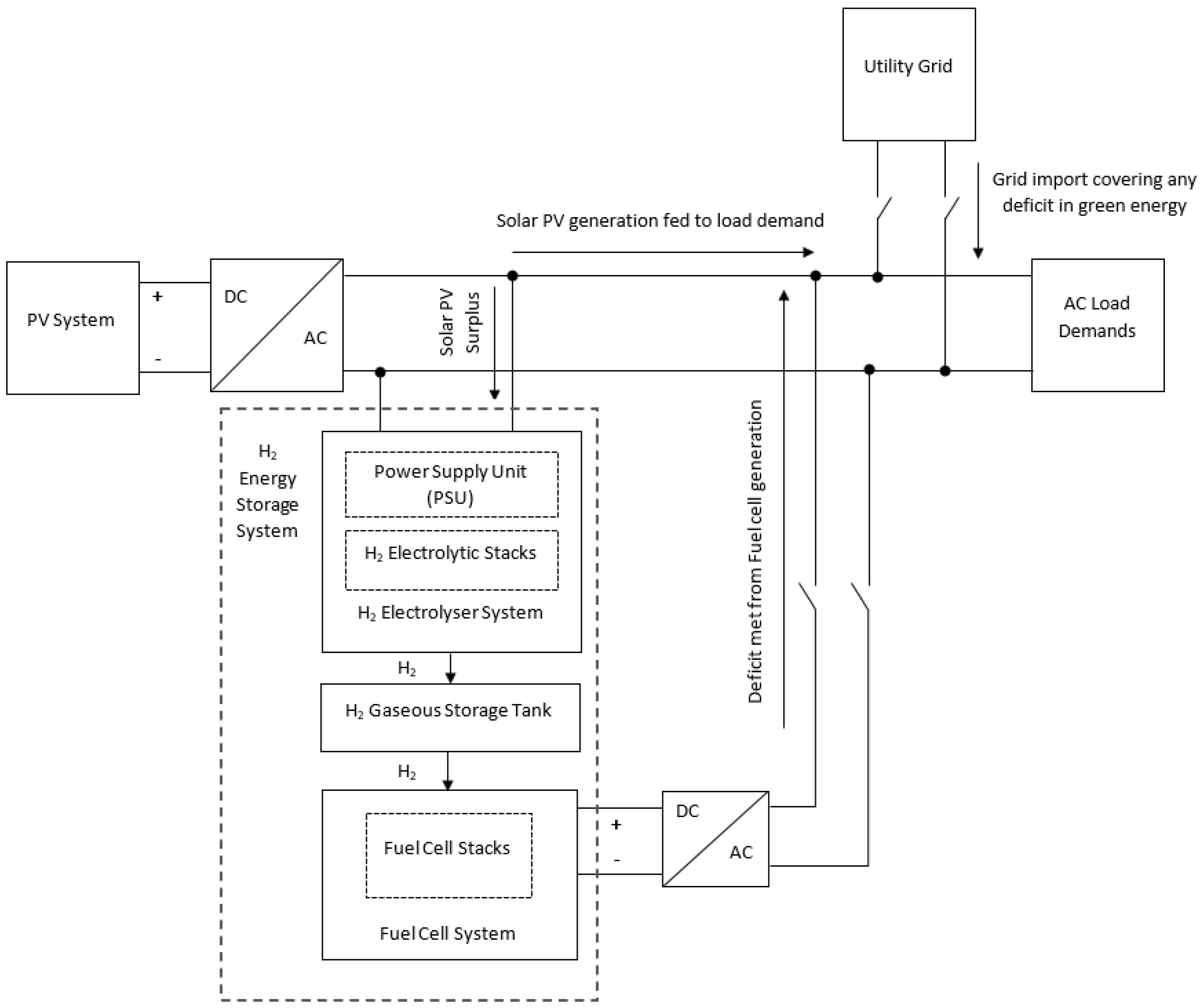
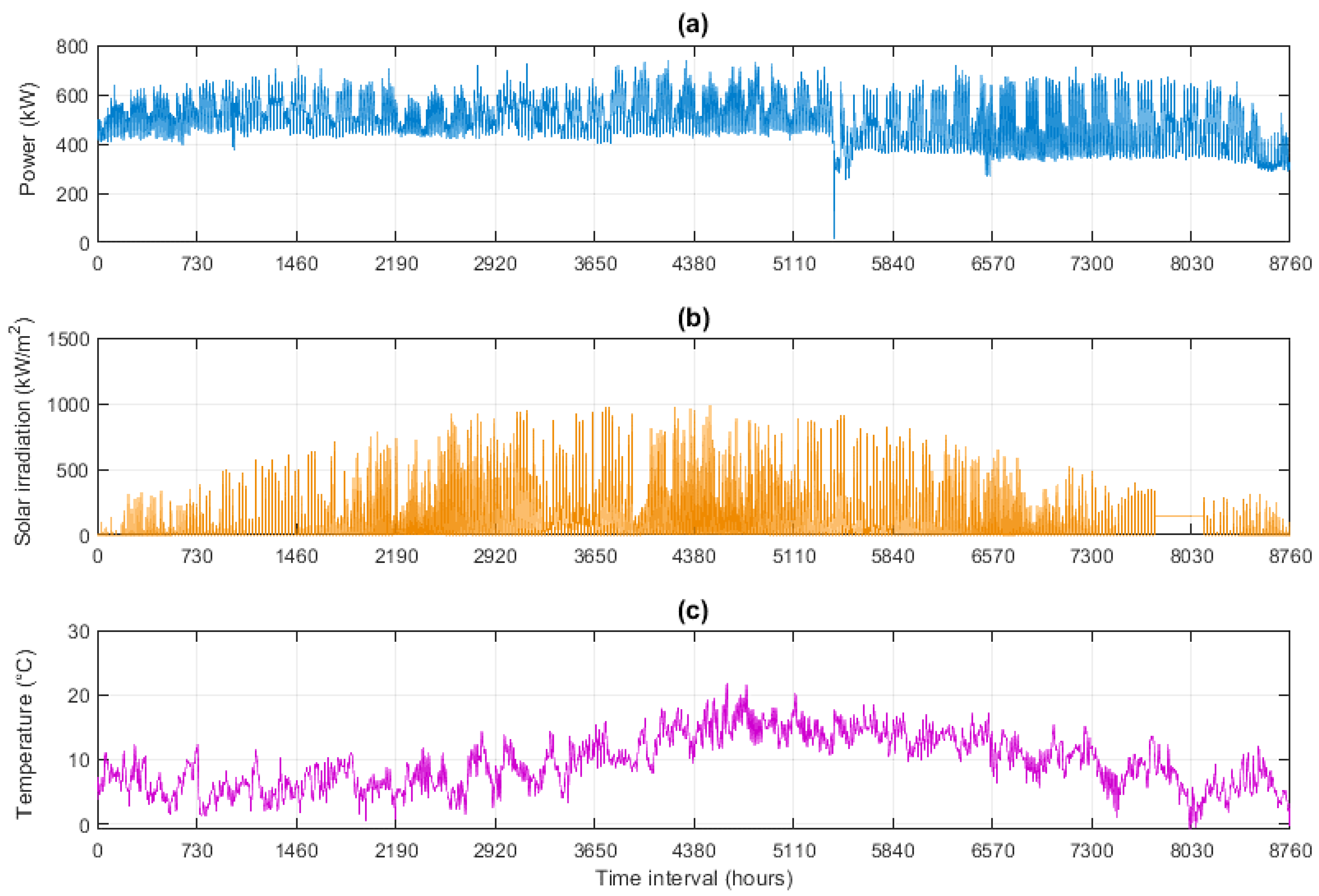
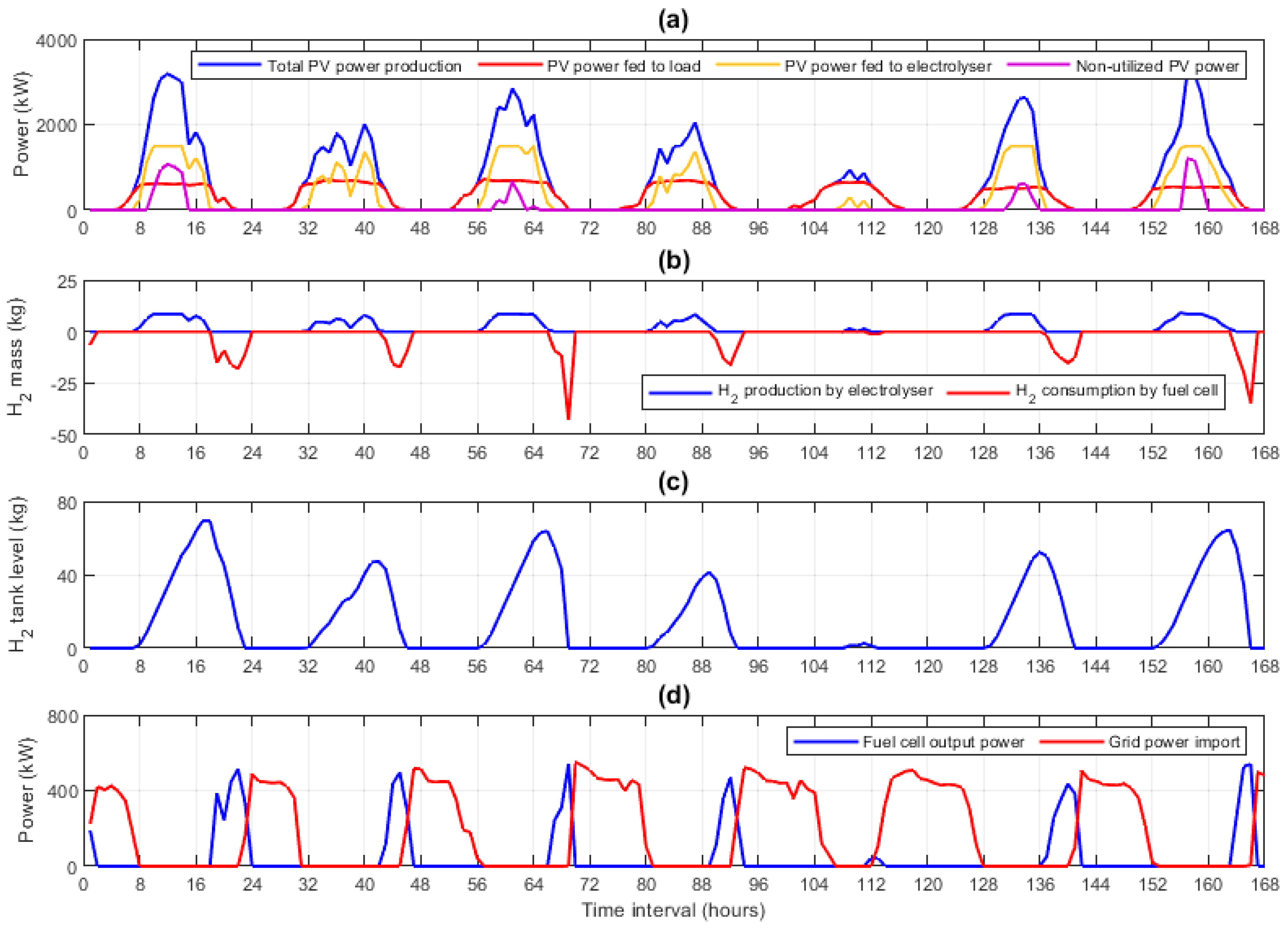
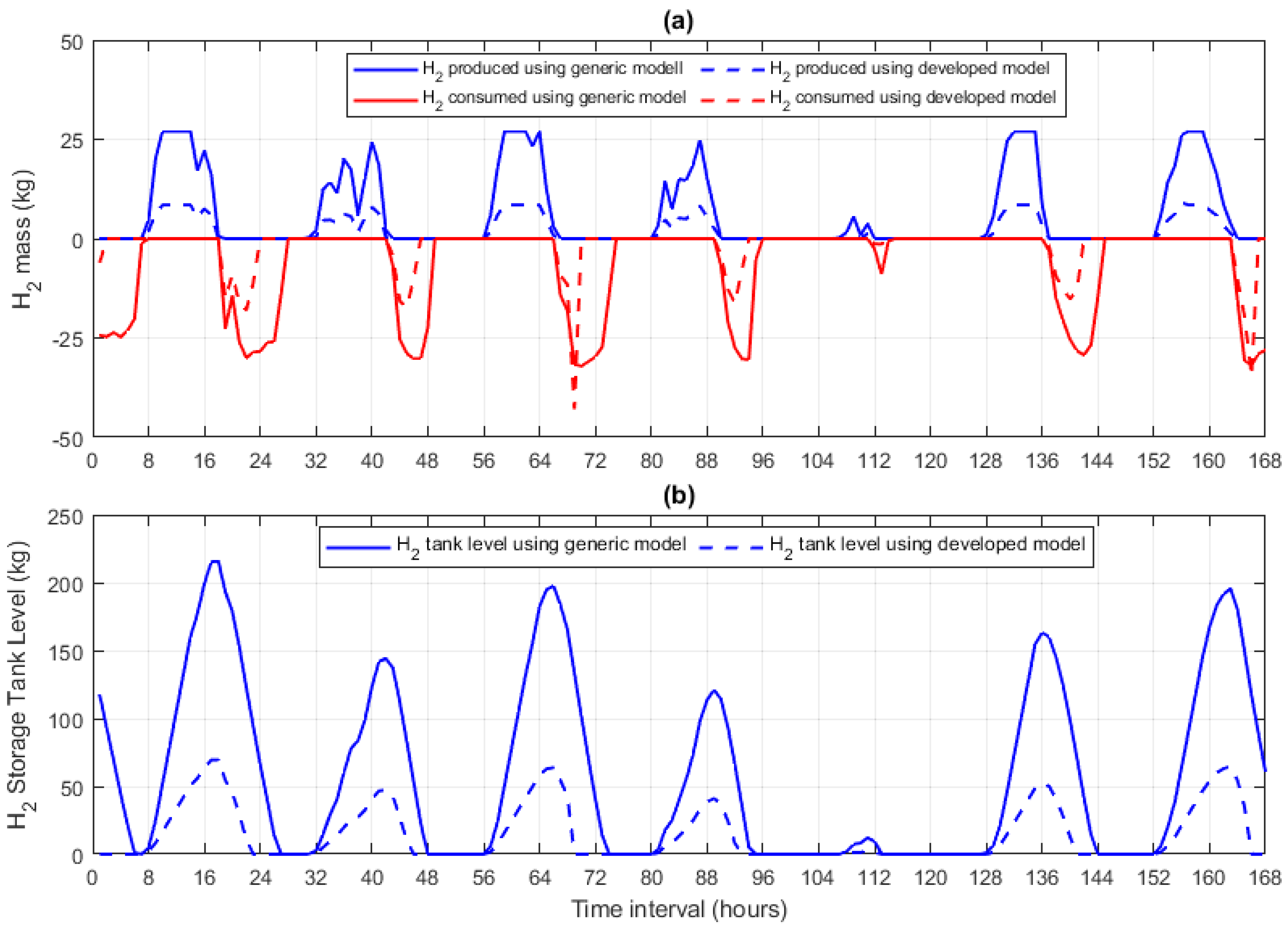
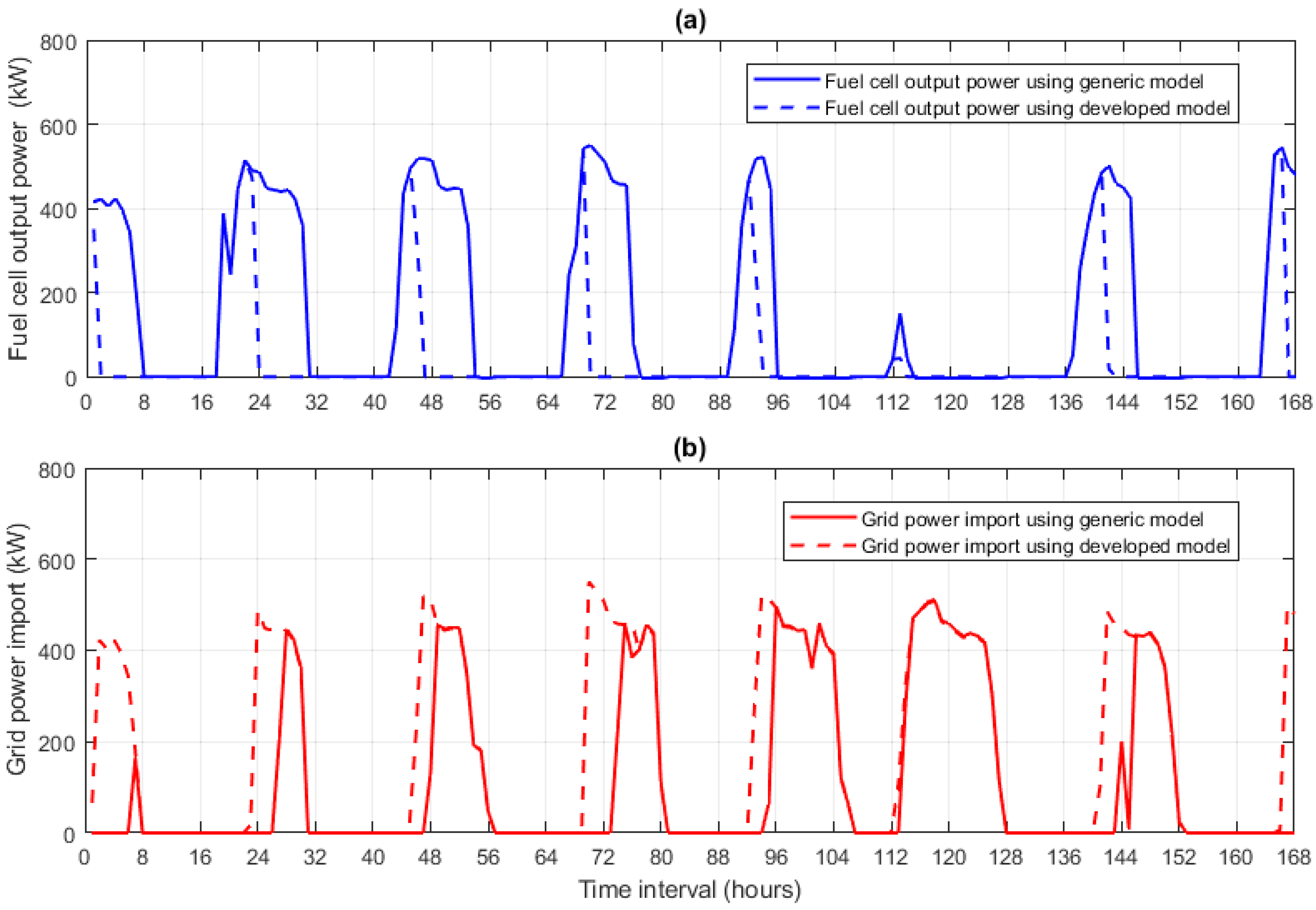
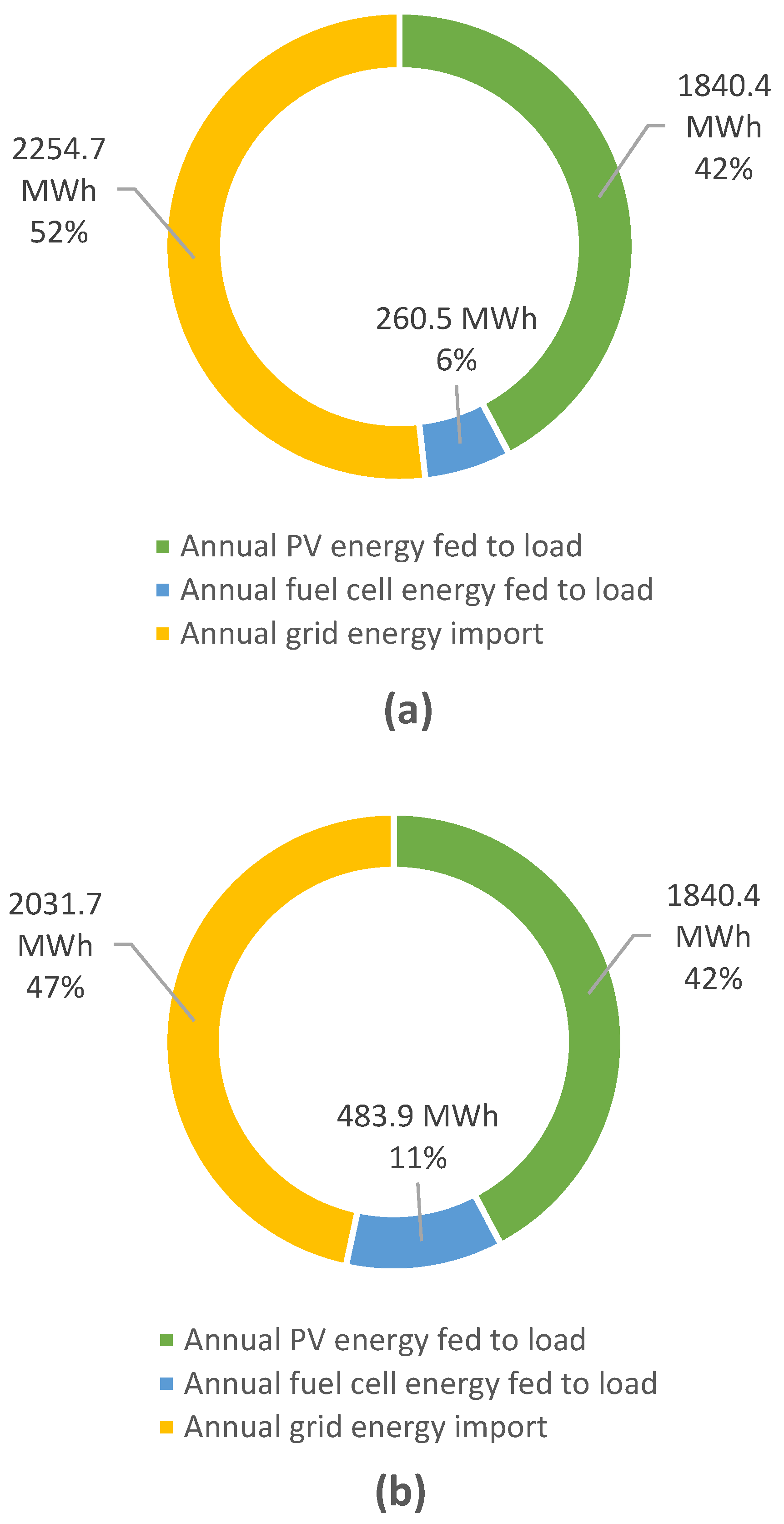
| Parameter | Description | Unit | Value |
|---|---|---|---|
| Electrode area | m2 | 0.06 | |
| Parameter used in modelling the Faraday efficiency | mA2cm−4 | 280,000 | |
| Performance coefficient empirically selected between 0 and 1 | none | 0.98 | |
| Number of cells per electrolytic stack | none | 180 | |
| Number of stacks used in building up the sized capacity of the electrolyser | none | 6 | |
| Rated capacity of electrolytic stack considered in building up the sized capacity of the electrolyser | kW | 250 |
| Parameter | Description | Unit | Value |
|---|---|---|---|
| Membrane active area | cm2 | 240 | |
| Membrane thickness | cm | 0.0178 | |
| Fuel cell temperature | K | 343 | |
| Resistive coefficient | Ω | 0.0001 | |
| Parametric coefficient | V/K | −1.01286 | |
| Parametric coefficient | V/K | 2.883 × 10−3 | |
| Parametric coefficient | V/K | 3.60 × 10−5 | |
| Parametric coefficient | V/K | −9.54 × 10−5 | |
| Humidification level of membrane | none | 20 | |
| Parametric coefficient | V | 0.0136 | |
| Maximum current density | A/cm2 | 5 | |
| Partial pressures of hydrogen | Atm | 1 | |
| Partial pressures of oxygen | Atm | 1 | |
| Number of fuel cells per stack | none | 100 | |
| Number of fuel cell stacks used in building up the sized capacity of fuel cell system | none | 86 | |
| Rated capacity of the fuel cell stack considered in building up the sized capacity of the fuel cell system | kW | 7 |
| Component | PV System (kW) | Electrolyser (kW) | Fuel Cell (kW) | H2 Storage Tank (kg) | H2 Gas Cylinder Volume (m3) | H2 Gas Target Pressure (bar) |
|---|---|---|---|---|---|---|
| Sized Capacity | 4155 | 1500 | 600 | 106.2 kg | 7.21 | 175 |
Disclaimer/Publisher’s Note: The statements, opinions and data contained in all publications are solely those of the individual author(s) and contributor(s) and not of MDPI and/or the editor(s). MDPI and/or the editor(s) disclaim responsibility for any injury to people or property resulting from any ideas, methods, instructions or products referred to in the content. |
© 2023 by the authors. Licensee MDPI, Basel, Switzerland. This article is an open access article distributed under the terms and conditions of the Creative Commons Attribution (CC BY) license (https://creativecommons.org/licenses/by/4.0/).
Share and Cite
Atteya, A.I.; Ali, D.; Sellami, N. Precise Dynamic Modelling of Real-World Hybrid Solar-Hydrogen Energy Systems for Grid-Connected Buildings. Energies 2023, 16, 5449. https://doi.org/10.3390/en16145449
Atteya AI, Ali D, Sellami N. Precise Dynamic Modelling of Real-World Hybrid Solar-Hydrogen Energy Systems for Grid-Connected Buildings. Energies. 2023; 16(14):5449. https://doi.org/10.3390/en16145449
Chicago/Turabian StyleAtteya, Ayatte I., Dallia Ali, and Nazmi Sellami. 2023. "Precise Dynamic Modelling of Real-World Hybrid Solar-Hydrogen Energy Systems for Grid-Connected Buildings" Energies 16, no. 14: 5449. https://doi.org/10.3390/en16145449
APA StyleAtteya, A. I., Ali, D., & Sellami, N. (2023). Precise Dynamic Modelling of Real-World Hybrid Solar-Hydrogen Energy Systems for Grid-Connected Buildings. Energies, 16(14), 5449. https://doi.org/10.3390/en16145449







